- Sky Blue Times
- Posts
- Club World Cup Data - Individuals
Club World Cup Data - Individuals

Club World Cup Data - Individuals
After the Club World Cup finished, FIFA released all the post-match reports from the tournament, so I dived into them and have pulled out lots of individual stats to go through for Manchester City. It’s worth mentioning at the start that these are small sample sizes, and the conditions of the tournament are very different from the peak of a Premier League season for the players. That being said, there are still plenty of interesting takeaways from the underlying numbers.
This is only for the individual stats; the team ones I will go through in a separate newsletter.
Here are the total minutes played at the tournament, another reminder of the limited sample size we are working with, especially for some players. John Stones and Marcus Bettinelli are the only players to get zero minutes. The new signings from the summer and January are highlighted in blue. Reijnders and Ait-Nouri straight into the lineup and racking up minutes. Marmoush played entirely in the place of Haaland in this tournament. Cherki eased in with minutes. Reis, Khusanov, Nico, and Echeverri were all long-term succession planning signings, not surprising to see them all only feature in one match. Rodri and Bobb, following their return from injury, were introduced to minutes across the games.
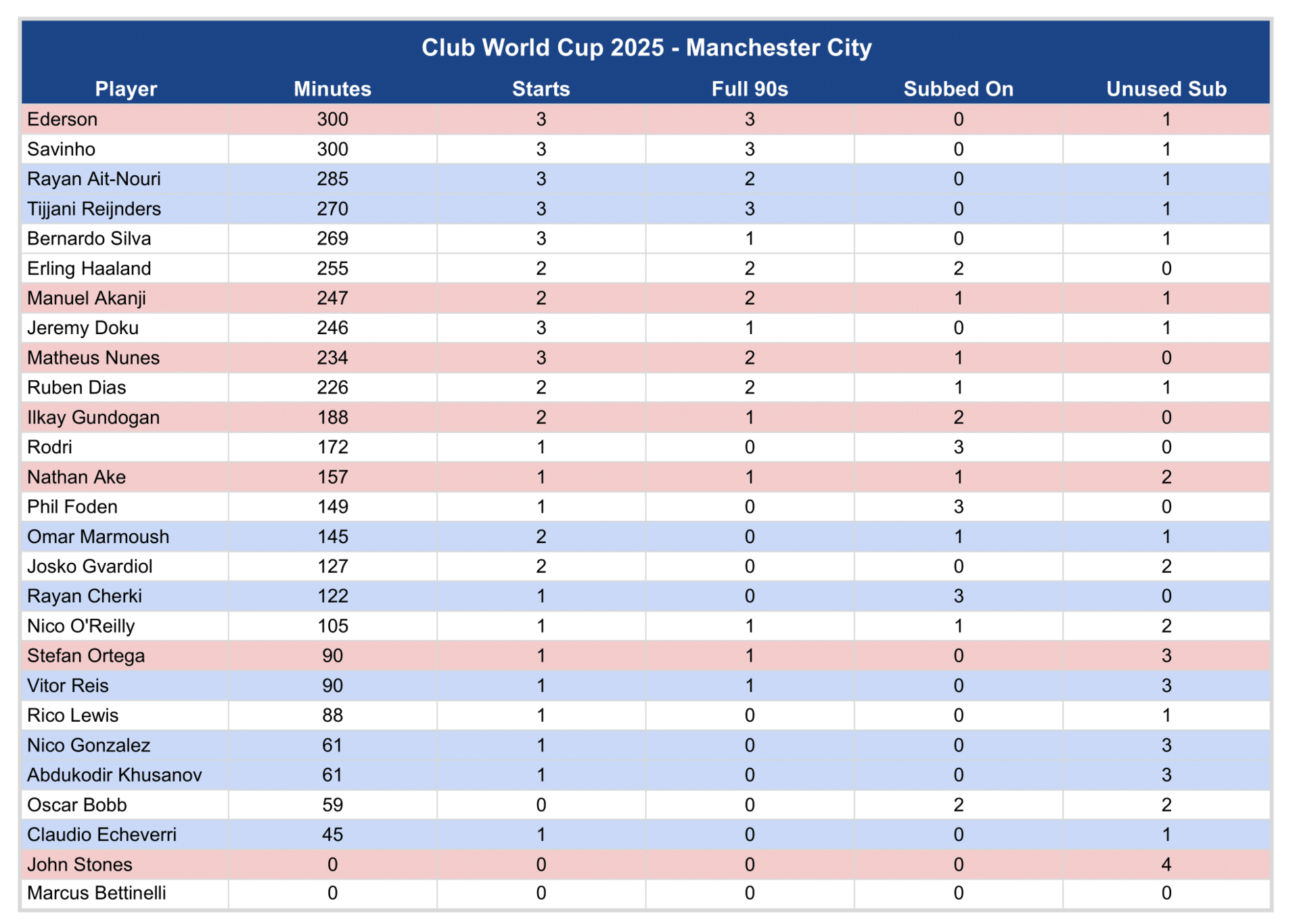
This is a more general metrics table from the Manchester City players at the CWC. Gvardiol (22.9), Rodri (22.6), and Nico (24.3) are top for line-breaking passes completed. The players are known for their passing ability, and you’d expect them to lead the way on these metrics. Other notable players are Cherki (16.4) and Reijnders (13.7), two midfielders coming in, compared to the likes of Bernardo (6.7) and Gundogan (7.6).
Jeremy Doku (11.5) is in a league of his own for ball progressions and take-ons. Ait-Nouri (3.8) and Cherki (4.3) are also standing out for these. Haaland (5.4), Marmoush (4.4), Foden (4.7), and Doku (4.8) are leading the way in shots. When you look back at last season, many of the players up either those players above were not at Manchester City, injured, or out of form. If you remove your high volume shooters and ball carriers, it’s easy to see why the team struggled a points last season.
“I'm someone who wants to give pleasure, who tries to do beautiful things with the ball while remaining efficient. I like to dribble and play with joy. You can feel it in every match. I give my all for the team and try to please my team-mates and the spectators. I want to enjoy myself on the pitch, give pleasure to others and bring back a bit of the football I used to play. My style is easy. I love to play with the ball; to do skills and I love to help my team-mates. I am here to make people happy and this is very important to me.”
Ball Progression - A distribution action performed by a player to breach the opposition team shape by intentionally bypassing one or more opposition players whilst carrying the ball into space or directly beyond an opponent.
Switch - A player attempts to pass the ball to a teammate who is on the other side of the pitch. The ball must progress through at least two vertical field zones. Data via FIFA
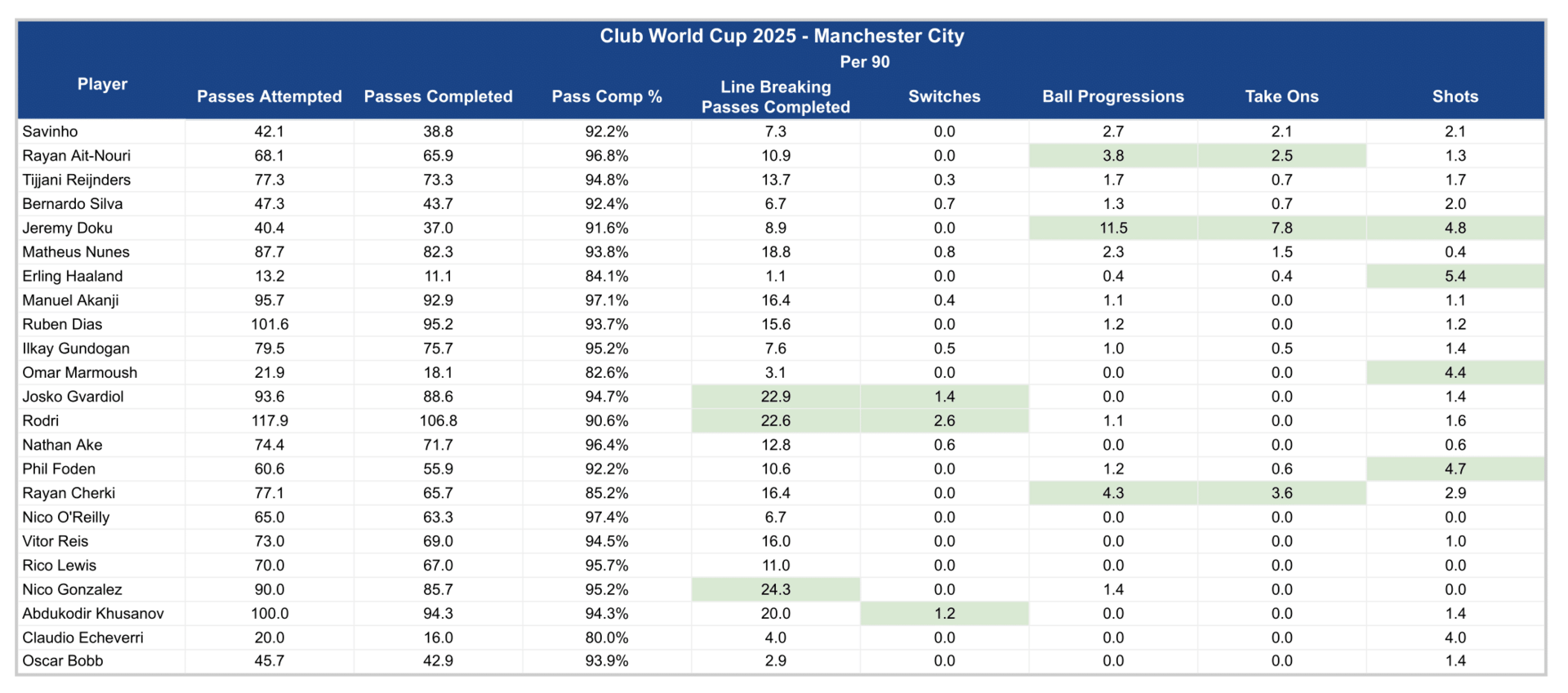
Now, if we’re looking at line-breaking passes from Manchester City players at the CWC in more detail, we can see a lot more than just the volume of successful ones. Josko Gvardiol (20.0) is racking up most of his by passing around the opposition block, which is expected for a central defender, and he’s followed by Vitor Reis (16.0) and Abdukodir Khusanov (15.7).
Josko Gvardiol (5.7), Rodri (4.7), Rayan Cherki (4.7), and Nico Gonzalez (4.3) all posted high numbers of line-breaking passes played over the top of the opposition block. Those kinds of passes were missed for most of last season. Compare that to Bernardo Silva (1.0) and Ilkay Gundogan (1.0).
Nico (12.9), Rodri (12.1), and Reijnders (8.3) posted high numbers for line-breaking passes played through the opposition block. All three will be playing midfield regularly for Manchester City next season. You compare those numbers to Bernardo Silva (2.7) and Ilkay Gundogan (3.8). It’s a huge jump.
I've highlighted the top three for each metric in green. The exception being LB - Over. Highlights the difference that just personnel changes will bring next season.
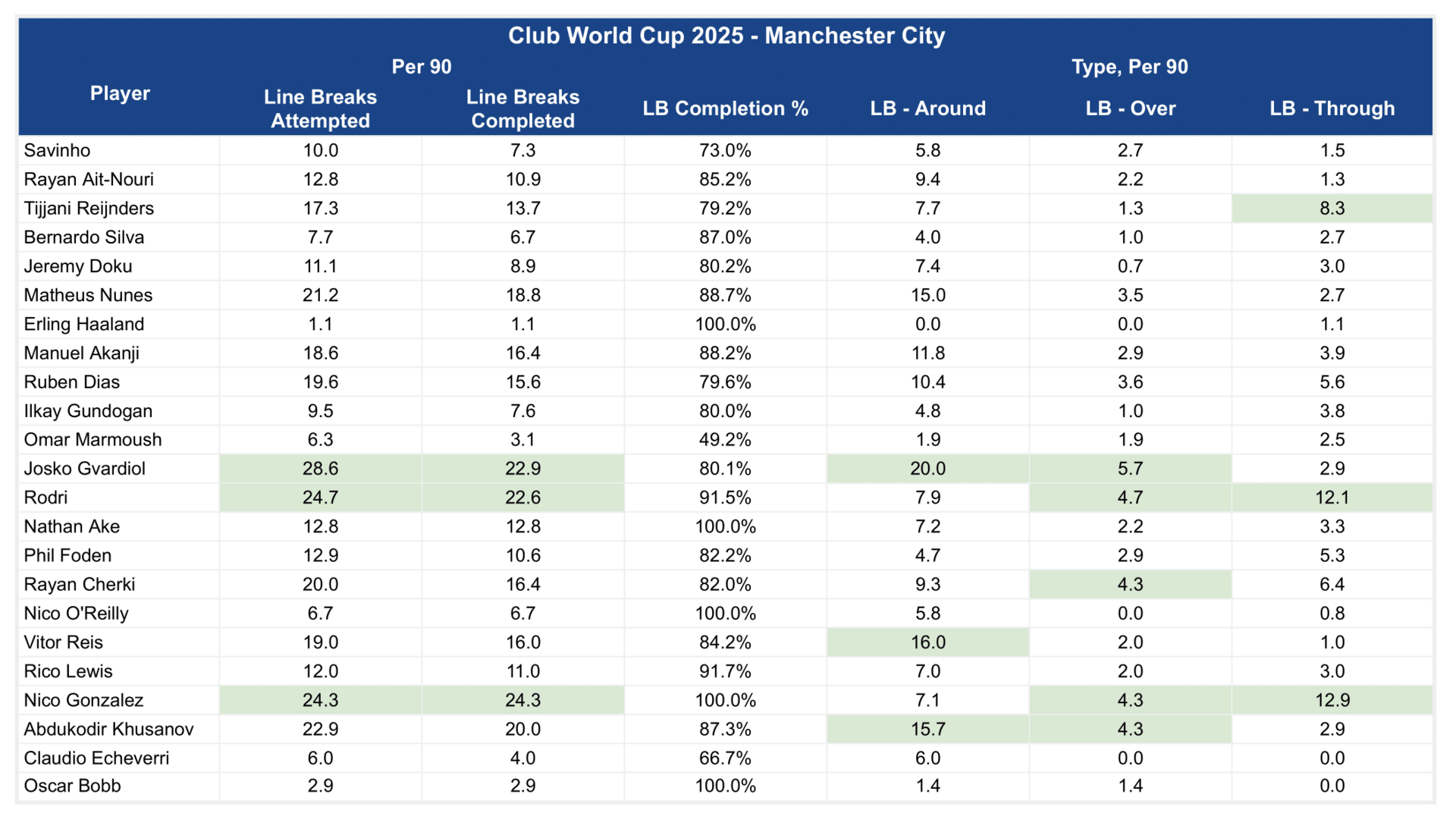
This one is looking at the number of movements players made during the CWC to receive the ball, how many of those passes were played into them, and the type of movement they made. Here are the FIFA definitions for each of those movements.
In Front - A movement to receive the ball in front of the opposition’s first unit line, which can happen in any third of the pitch and either inside or outside the opposition team's shape.
In Between - A movement to receive the ball between two units, inside the opposition team's shape.
In To Out - A movement from inside the opposition team shape to outside the opposition team shape to receive the ball between the first and final opposition team unit.
Out To In - A movement from outside the opposition team shape to inside the opposition team shape to receive the ball between the first and final opposition team unit.
In Behind - A movement to receive the ball behind the opposition’s final unit.
It’s not a surprise to see the likes of Phil Foden (121.2) and Rodri (80.0) always moving to make themselves available for the ball. Echeverri (138) is similar to Foden in that aspect. It’s why they receive the ball a lot. Your central defenders won’t need to make a lot of movement due to their position and the way Manchester City play. Rodri, Foden, and Nico are all top for in-front movements, which, for the two defensive midfielders, is expected.
In these metrics, you can see how well Foden moves to receive the ball. Similar to Cherki and Echeverri. The number of runs Marmoush (33.1) makes behind, as well as dropping deep to find space between the lines (16.3).
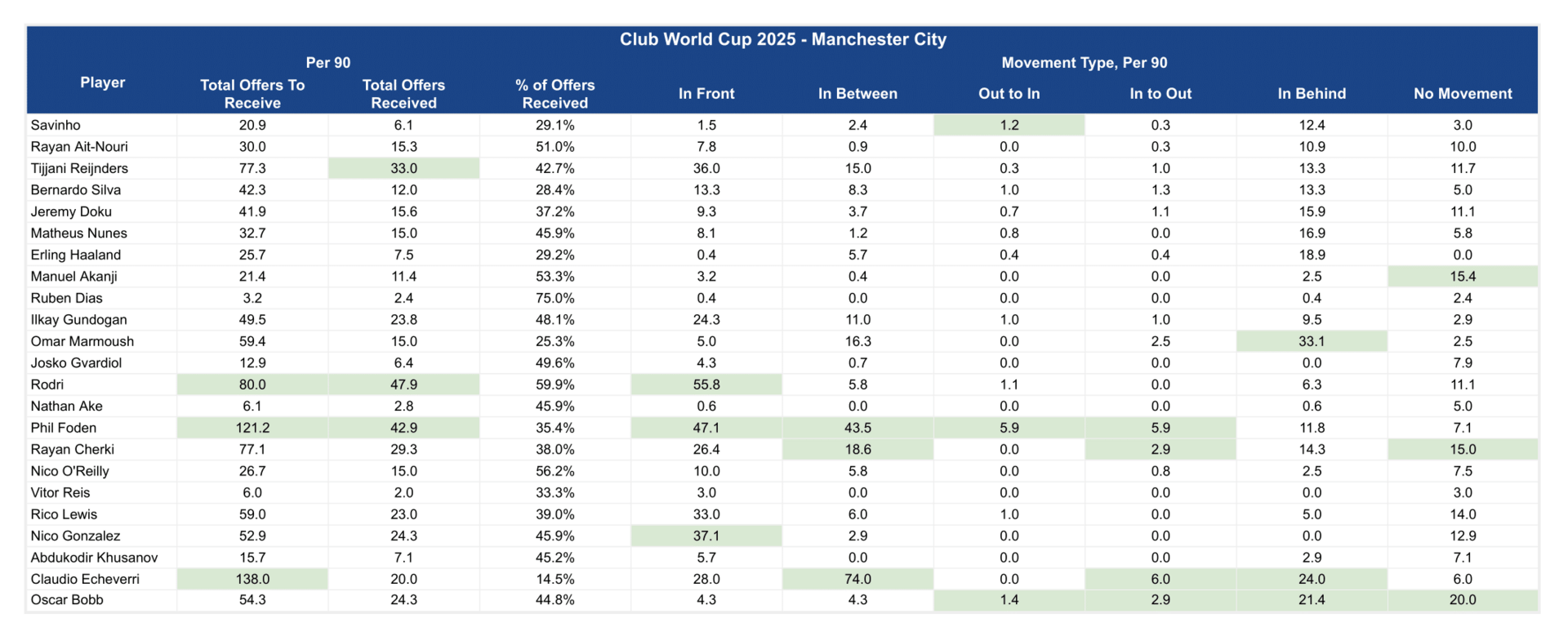
Here is a quick look at trying to visualise the data for the run types players make to be available for the ball. Comparing Phil Foden and Rayan Cherki, you can see the percentage of offers Cherki makes without moving. He’s making a bigger percentage of his runs in behind. Foden is mixing in more movements from out to in and vice versa.
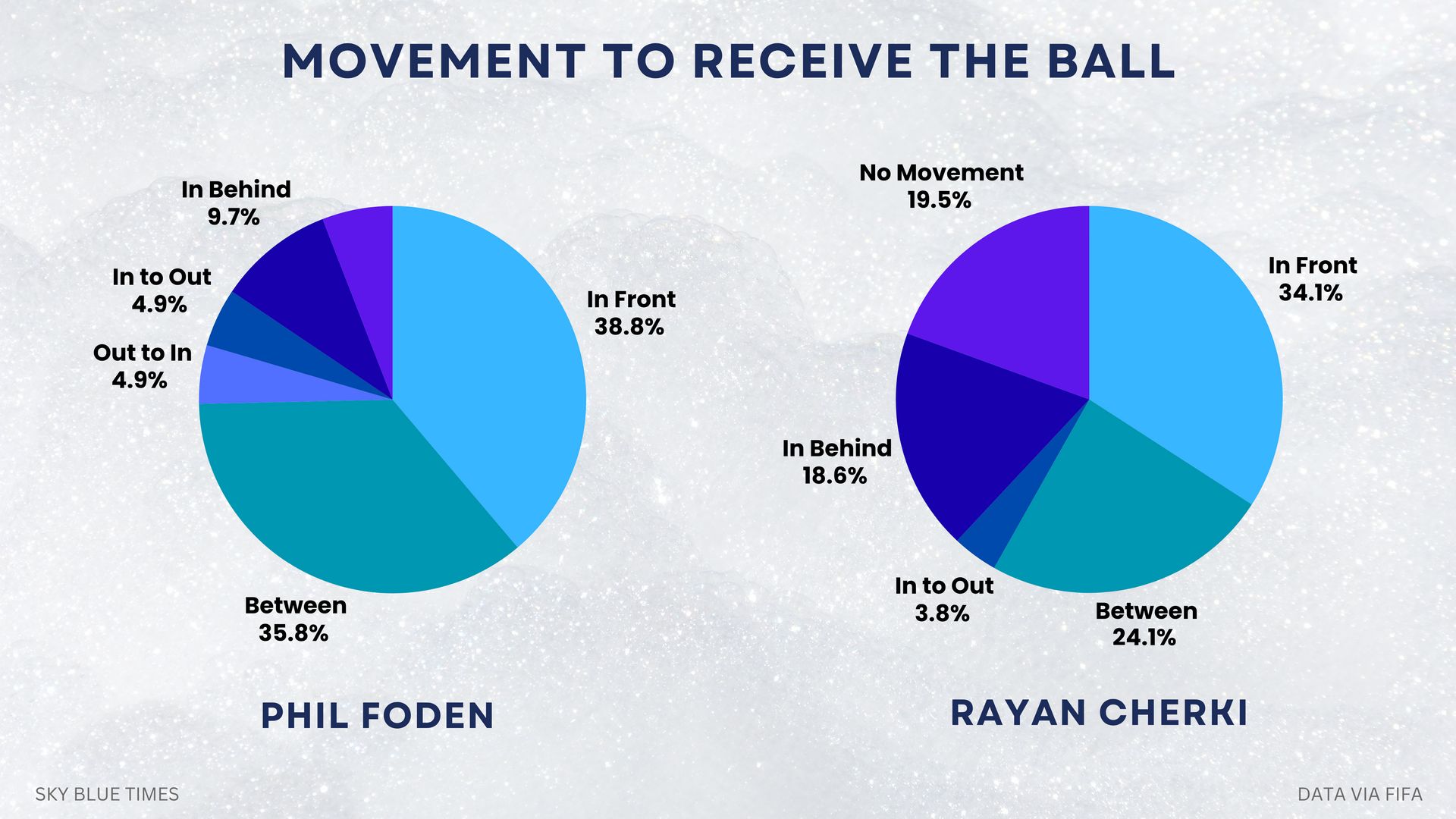
Here is a different one, looking at pressing metrics, and highlighting the top three in each in green. Matheus Nunes (7.7), Rodri (6.8), and Phil Foden (5.9) lead the way for direct pressing. Encouraging to see Foden, showing how much better he’s moving on/off the ball. Erling Haaland (29.3), Rayan Cherki (29.3), and Oscar Bobb (34.3) are the top three for pressing indirectly. That’s one of the reasons why Bobb was a huge loss last season.
Bernardo Silva (25.0) in the top three for pushing on and for pushing on into press (15.3) should give you an insight into his consistent selection last season in midfield, compared to players like Ilkay Gundogan (6.2, 3.3). Rodri is leading the way for loose ball receptions (9.5).
Pressing Direct - A player has directly and aggressively closed space between themselves and the opposition player with the ball, and can compete for the ball.
Pressing Indirect - A player may be trying to close down the space and control the direction in which the opposition player in possession can move with the ball, but is not attempting to directly recover possession themselves.
Pushing On - A player attempts to close down the space between themselves and an opposition player when the opposition player does not have the ball.

The last one for today is the physical data from the CWC for Manchester City players. As with all of them, worth remembering that they are small samples and plenty of factors are going into the performances. Just as was pointed out in the pressing graphic, it's clear to see one of the values Bernardo provided across his career.
Reijnders, Bernardo, Dias, Gundogan, Rodri, Foden, Cherki, Gonzalez, and Echeverri average above 11km per 90. When it comes to the high-speed runs and sprints, these are a good sign for Phil Foden returning to his best and Rayan Cherki starting well next season.
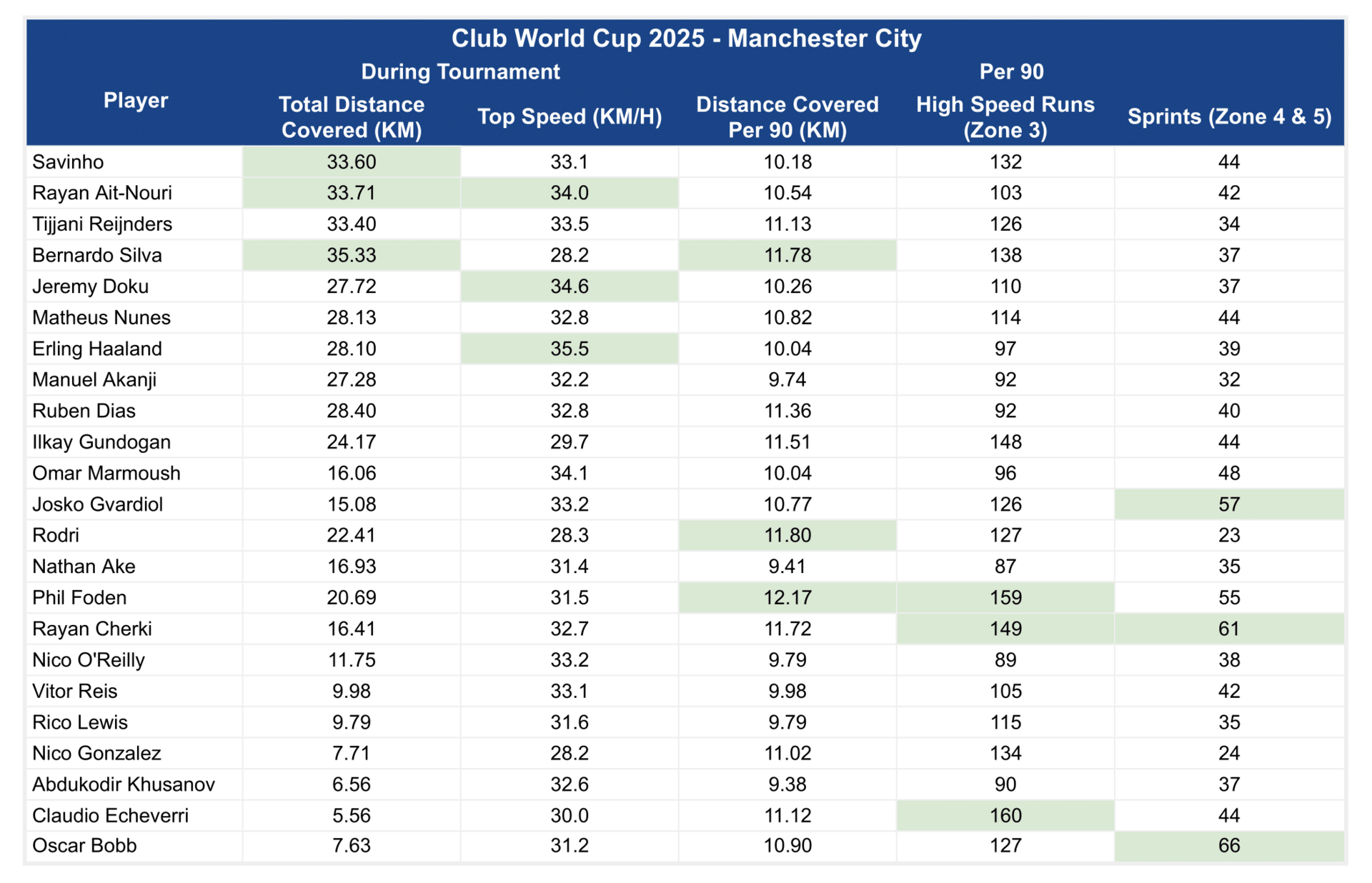
That’s everything I’ve put together from the individual underlying numbers, which appear favourable for the new signings and the ones making a return from injury. Phil Foden looks to have found his movement against on both sides of the ball, ahead of the new season. You can see quite clearly how the midfield will be improved, the increase in runs to open space, and eventually generate better chances. The strengths each attacking player brings to the table, some of which we’ve missed all of last season or for most of it, for different reasons.
I’ll be doing another newsletter on the team-related underlying numbers next. If you’ve got any questions or suggestions for the next one, please let me know in the comments below. You can also send an email reply.
If you want to see me talk through all of the underlying numbers in a video, then check out the one linked below. 👇
If you wanted to go through the data yourself, then you can find all the post-match summary reports linked below for the entire Club World Cup 2025 and the Manchester City matches:
If you haven’t already, subscribe to get all this Manchester City content right to your inbox.
Up the Blues.
Reply